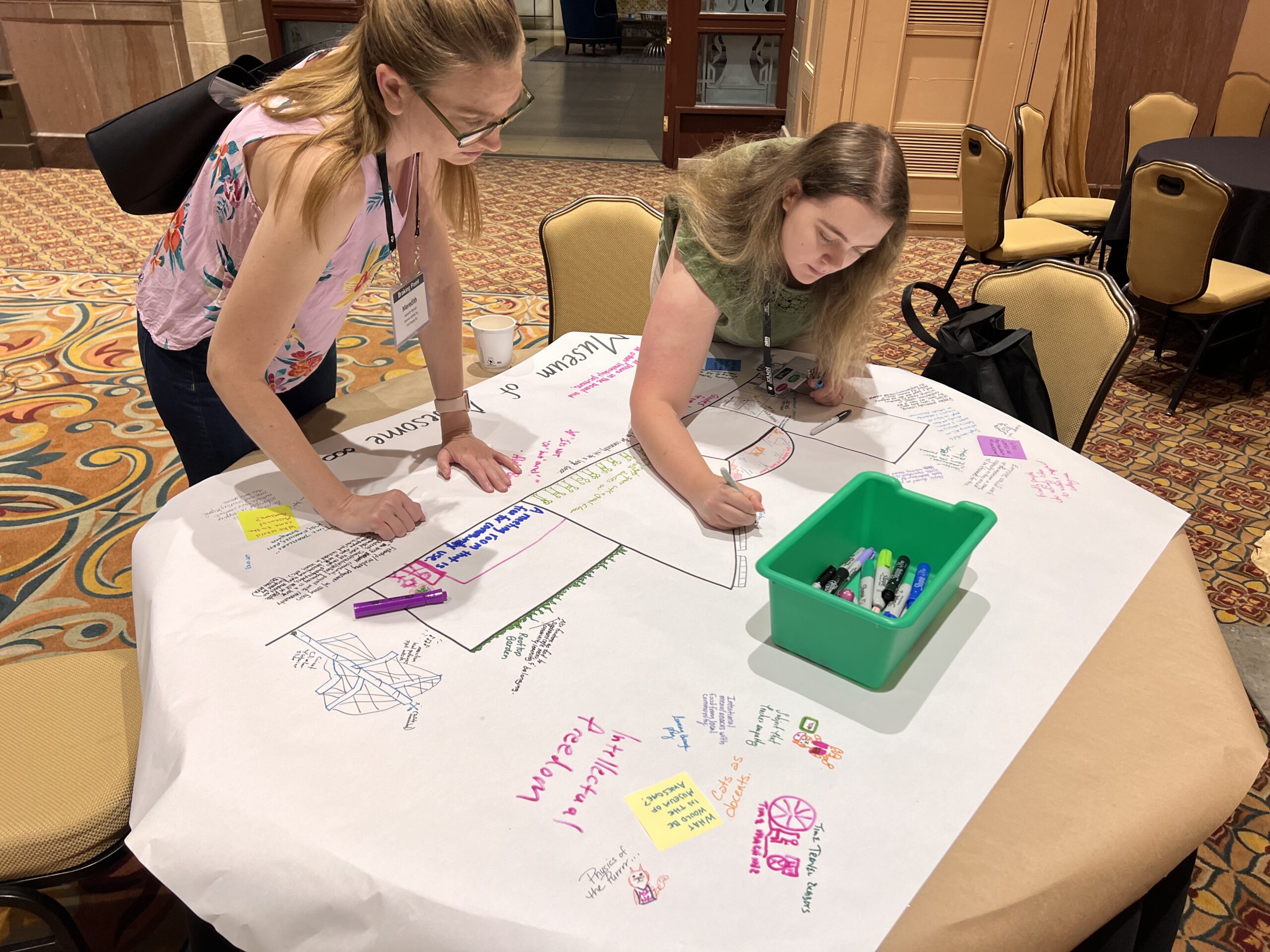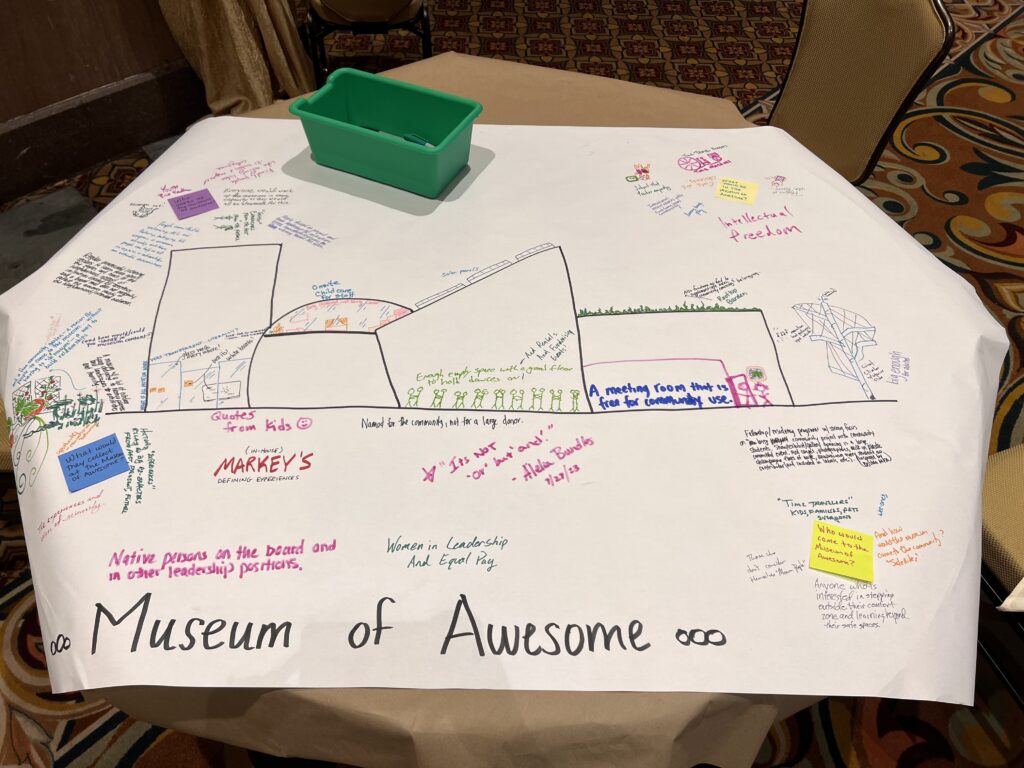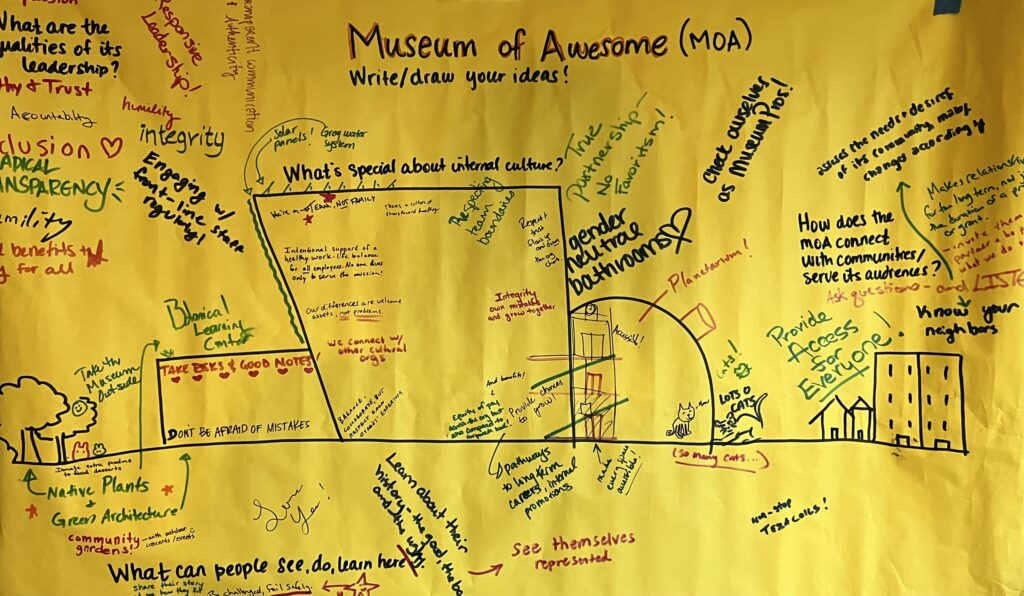For the last two years, AMM Executive Director Charity Counts has asked conference attendees to help envision a “Museum of Awesome” using a visual brainstorming activity. Attendees both years were offered a few question prompts to consider and then invited to sketch or write their ideas on a blank drawing of a “museum.” In this post, Charity summarizes what she’s learned from their responses.
What is the Museum of Awesome? Originally started as the collective dream of two friends and coworkers, the Museum of Awesome is a concept that represents the ideal museum. In our original imaginings, it had all of the things we loved about the museum we were working in, mish-mashed with the best-of-the-best of others. More importantly, the Museum of Awesome brought together all of the amazing museum people we knew to lead, develop exhibits, run operations, and market it. No bad eggs.
I’ve used this concept as the basis for conference brainstorming activities for two reasons. The first is that, deep down, I still dream of seeing this museum come to fruition! Most of all, though, it is fun to think about the “ideal museum” – from both internal and external perspectives. The notion of a Museum of Awesome opens our minds up to consider what is possible when we don’t try to fit it into an existing mold. It’s a freeing thought too – to get to work in the Museum of Awesome.
- In 2023, we asked: What would be in the museum? What would they collect? Who would come to the museum? Who works there?
- In 2024, we asked: What are the qualities of its leadership? What’s special about the internal culture? How does the museum connect with communities/serve its audiences? What can people see, do, and learn here?
The responses have some common threads. Let’s dig into the key features of the Museum of Awesome!
Accessibility, Inclusion, and Belonging are Central to the Equation
This should be no surprise. It is the single greatest effort taking place in our profession right now. It’s challenging, though, and if a few priorities can be gleaned from the ideal Museum of Awesome, it’s these:
- Kids and grownups can do it. We make sure the whole family can participate, on some level.
- All of our employees are AWESOME, of course. That means being intentional in our work and helping everyone to feel that they belong.
- At the team level, we see our differences and diversity of experiences, abilities, and knowledge as assets.
- We bring our authentic, whole selves to our work in service to the museum’s mission, but we respect that this isn’t the only thing going on in each of our lives.
We’re Seeking Something More Than “Community Engagement”
At the Museum of Awesome, we go beyond traditional notions of community engagement. This is about doing more than just inviting our community in as partners on projects. It’s about listening to and addressing their needs, seeing the museum’s services as “of/by/for” them. (Not of/by/for us.) That’s our mission. Attendees describe the Museum of Awesome as a place where just about every decision considers the impact on, care for, and opportunities for the communities served.
- Community members are so integrated into the museum, that everyone is engaged in some capacity, uses the spaces and resources we offer regularly, and sees themselves as stewards of the mission too.
- We’re solving real community needs like access to food, through community gardens, and keeping our footprint “green” so our impact on the local ecosystem and environment is a positive one.
- We also don’t expect people to come to the Museum of Awesome to be involved. We’re out and about in the community regularly!
Trust Flows Up and Down
We received a lot of write-in comments about internal cultures and qualities of leadership at the Museum of Awesome. It should be no surprise that this ideal museum has leaders you trust and and a work culture that kicks ass. Here’s what’s happening at the Museum of Awesome to make it so:
- Leadership team members aren’t aloof. They regularly interact with employees, especially at the frontline, and are transparent about decisions and direction for the organization.
- Our leaders and staff do their work with integrity, they don’t show favorites, and they own their mistakes when they make them.
- Our employees are not afraid to take risks and make mistakes, but we for sure take good notes to learn from them!
- Employees are paid competitive wages based on not just what the organization is paying others, but what the world outside is paying similar positions.
- We’ve not let the department/division silos get in the way of progress.
Cats. So Many Cats.
We aren’t sure why this happened, but it did. The Museum of Awesome has many, many cats. They are docents. They are comfort. They are AWESOME. Oh, that’s why it happened!
Obviously, many ideas come out of brainstorms like this. (You’ll find the full list below.) It has been fun to invite others into the process of imagining the ideal museum and building on the humble notions that my friend and I had all those years ago. Don’t let these great ideas stop here. Keep imagining what is possible in the Museum of Awesome… and how that might translate to your organization. I know I will!
Dedication
This article is dedicated to Sarah Cole, President and CEO of Glazier Children’s Museum in Tampa, Florida, my co-conspirator on the notion of a Museum of Awesome and who is no doubt leading by example in many of these areas. I also want to give a shoutout to the many people and places we encountered that inspired us to ponder the Museum of Awesome in the first place. You will never know who you are!
Here is a list of all responses to the prompts:
What would be in the museum?
- Learning through play
- Intentional menu/snacks with food from local communities
- Time machine! Time-travel exhibits
- Subject that teaches empathy
- What if all museum work was transparent, literally, for coworkers and visitors, with glass walls everywhere
- Opportunities to write questions and ideas on post-its and white boards
- Quotes from kids
- A lot of outdoor space dedicated to native plants and landscapes for activities and learning
- Educational pathways
- A community garden – a reason to come to the museum without having to “do museum,” a reason to build relationships
- Enough empty space with a good floor to hold dances on – and rentals and fundraising events!
- A meeting room that is free for community use
- Rooftop garden that also functions as food supplement for cafe, focus for community learning and belonging
- Giant climber with interior slide, big enough for adults, with music from local performers piped outside, and safely grounded
What would they collect?
- The experiences and voices of the minority
- History “experiences” relayed by re-enactors from past, present and future
Who would come to the museum?
- “Time Travelers” – kids, families, pets, everyone!
- Wee-ones
- Those that don’t consider themselves “museum people”
- Anyone who is interested in stepping outside of their comfort zone and learning beyond their safe spaces
- PLUS museums could come to the community through satellites
Who works there?
- Friendly people who actively listen to visitors and respect colleagues
- Youth – paid youth
- Museum cat! / Cats as docents
- People committed to welcoming ALL and fostering belonging, because everyone is awesome already and these people can help us all recognize and acknowledge our authentic awesomeness
- Everyone would work at the museum in some capacity, because they would all be stewards for this!
- “Ghost characters” from the past and future
- People focused on project and team leadership for initiatives across departments/divisions – working toward fewer silos
- Fellowship/residency programs with strong focus on big community project(s), like a show/exhibit/gallery opening
What are the qualities of its leadership?
- Compassionate
- Responsive
- Transparent communication/Radical transparency
- Authenticity
- Empathy
- Trust
- Accountability
- Humility
- Integrity
- Respect
- Engaging with frontline staff
- Inclusion
- Good benefits and pay for all
What’s special about internal culture?
- We’re a team, not a family
- Strong record-keeping
- Respecting team boundaries
- Respect and trust flows up and down through the org chart
- Intentional support of a healthy work-life balance for all employees. No one lives only to serve the mission!
- Our differences are welcome assets, not problems
- Integrity – we own our mistakes and grow together
- Equity of pay and benefits across the org but also compared to corporate world
- Provides chances to grow – pathways to long-term careers and internal promotions
- Balance – collaborate, but respect each others’ experiences
- We connect with other cultural orgs
- Aren’t afraid of mistakes
- Take risks and good notes!
- True partnership, no favoritism!
How does the museum connect with communities/serve its audiences?
- Ask questions and listen
- Know their neighbors
- Makes relationships for the long-term, not just the duration of a project or grant, and invite them to partner and be part of what we do and share
- Assesses the needs and desires of its community, making changes accordingly
What can people see, do, and learn here?
- Learn about their history – the good, the bad, and the ugly
- Share their story and see how they fit into the bigger story
- See themselves represented
- Be challenged, fail safely
- Community gardens, with outdoor concerts/events, native plants, and donate extra produce to food deserts
- Green architecture, like gray water systems and solar panels
- Take the museum outside!
- Botanical learning center
- So many cats!
- Planetarium
- Gender neutral restrooms
- Access for all / everything is accessible!
- Non-stop tesla coils!



